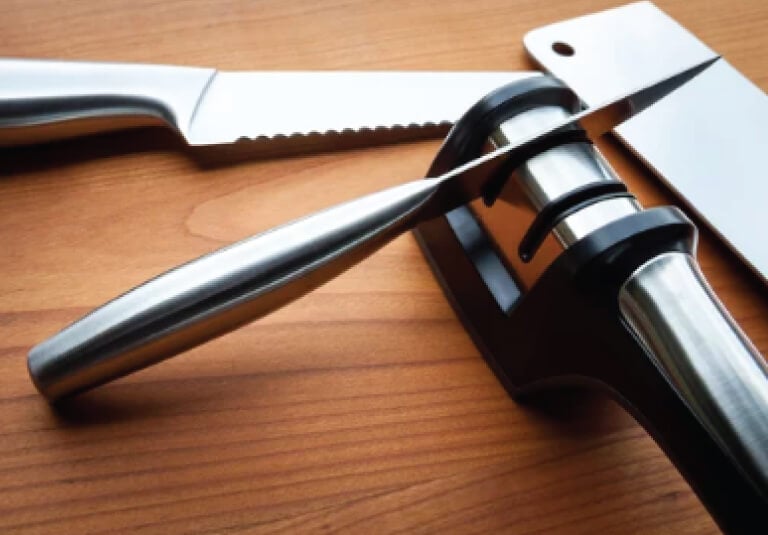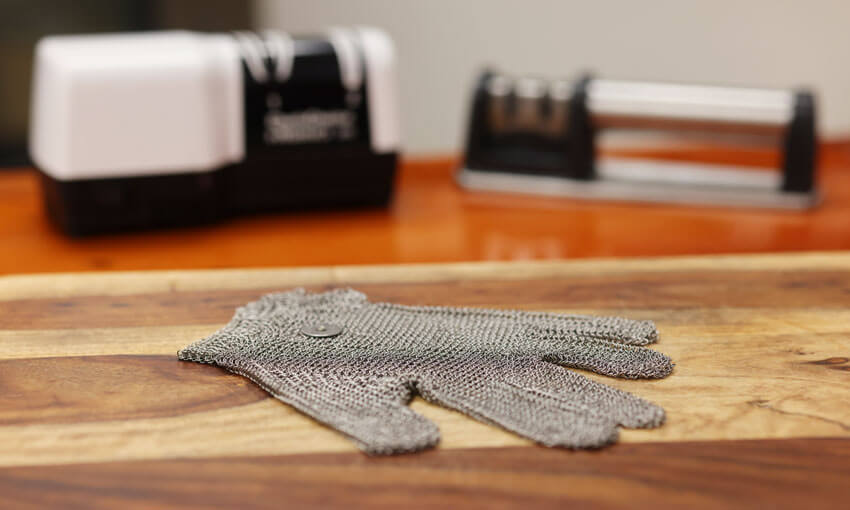How to Sharpen Knives at Home

Table of Contents for How to Sharpen Knives
How to Sharpen Knives Overview
Keeping your kitchen knives sharp is not only essential for efficient cooking but also for your safety. In this blog post, we’ll walk you through the process of sharpening your knives safely, highlighting the importance of precautions and introducing both manual and electric sharpeners as well as a stone sharpener. So, let’s dive in and learn how to achieve razor-sharp edges for your knives so that the next time you want to cut through various cuts of steak or meal prep some vegetables for the week, your fingers will be safe and still intact!
How to Sharpen Knives Using a Knife Sharpener Video
Different Types of Knife Sharpeners
Manual Sharpener
Understanding the manual sharpener: Manual sharpeners typically consist of a coarse side and a fine side.
How to use a Manual Knife Sharpener: Place the knife against the coarse side of the sharpener and swipe it across the surface around ten times. This initial step sets the foundation for a sharp edge. Afterwards, switch to the fine side of the sharpener and repeat the swiping motion ten times. This step further hones the edge, making it sharper and more precise.
Electric Sharpener
Understanding the electric sharpener: Electric sharpeners often offer a fine side and an additional step for removing burrs.
How to use an electric sharpener: Turn on the electric sharpener and glide the knife along the fine side approximately five times on each side. This process provides a polished, razor-sharp edge. Afterwards, in order to remove the burr from the knife, glide the knife along the burr removal side approximately two times, and repeat this step a couple of times as needed for a flawless edge.

Electric Knife Sharpener (Left) and Manual Knife Sharpener (Right)
How to Sharpen Knives Using a Stone Video
How to use a Stone Sharpener Written Instructions
Stone sharpener anatomy: Stone sharpeners are rectangle or oval-shaped and offer a coarse and fine surface.
How to use a stone sharpener: First, prepare your sharpening stone by adding stone oil to the surface of the stone. Next, position the kitchen knife at about a 15-to-20-degree angle against the coarse side of the stone. Use light pressure to move the knife across the stone in a seeping motion and repeat this several times. Then do the same on the find side of the stone and proceed to move the knife against the honing rode to remove the burrs as your final step.

Knife Sharpening Stone
Prioritize Safety When Sharpening Knives
Cutting Gloves
Begin by donning cut-resistant gloves, which can be found at restaurant supply stores. These gloves provide an extra layer of protection, minimizing the chances of accidental cuts. And to be extra safe, double up the glove by adding an additional layer of safety by wearing a food handling glove on top of the cut glove. This ensures a secure grip while protecting your hands during the sharpening process.
Different Types of Cutting Gloves
Cut Resistant Fiber Glove: Fiber gloves are commonly made of high-performance materials that are known to be exceptionally strong and provide excellent cut resistance. Fiber gloves come in different cut levels, meaning that the higher cut levels offer increased protection against sharper objects. These gloves are more accessible and more flexible to use, allowing for more precise movements while handling a knife.

Cut Resistant Fiber Glove
Mesh Steel Cutting Glove: These steel cutting gloves offer a high level of protection against sharp objects and tend to be more durable and resistant to wear and tear. These can often be found being used in various industries and applications where there is a higher risk of cuts and punctures, for example a restaurant that requires large amounts of prep may utilize these mesh steel cutting gloves over the fiber gloves.

Mesh Steel Cutting Glove
Sharpening Knives Notes
Emphasize Caution: Handle knives with care by always exercising caution and mindfulness. Knives can cause severe injuries if not handled properly.
Be attentive and focused: Stay fully present while sharpening your knives, ensuring that you’re aware of the blade’s movement and your hand’s position at all times to prevent any injures.
Prioritize safety over speed: Take your time and proceed slowly to maintain control and reduce the risk of accidents.
By following these step-by-step instructions, you can sharpen your knives safely and effectively. Sharpened knives not only enhance your cooking experience but also contribute to a safer kitchen environment. Go ahead and try your newly sharpened knife next time you find yourself having to filet a salmon or if you find yourself having to cut vegetables for a recipe such as a vegetable alfredo pasta sauce, to get the full experience of a newly sharpened knife! So, stay sharp, stay safe, and enjoy the precision and efficiency that sharp knives bring to your culinary adventures!